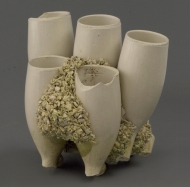Lumb of pipe bowls
January 2018

Gouda pipe makers developed an ingenious system for baking their clay tobacco pipes. The long unbaked pipes were placed in a high earthenware pot, a saggar with the bowls down. The pots were then filled with a grit of crushed pipes. That grit ensured uniform heat conduction and prevented the pipe stems from warping. The filled saggars are then delivered to a potter. This potter first placed the pipe pots on the kiln floor, after which he further filled the dome of the kiln with his own lead-glazed earthenware. When the kiln was fired, the glaze of the pottery melted and sometimes started to run and so it dripped onto the lids of the saggars. In rare cases this even leaked into the pot. The unintended result is this mess of glazed clay pipes that have been clogged together, including some crushed pipes. Such misfires naturally led to disputes between the potter and the pipe maker. Who was responsible for the damage? It is a miracle that this problem did not occur often. Such mis backed pipes are rare in Gouda as archaeological finds. The pipe bowls of this find still show the makers mark skater, at that time owned by Joris de Liefde. The production took place between 1760 and 1780. These misfired pipes were found in the Kandeelstreet in Gouda, a side street of the Raam. At the time, this was the pipe makers' center in Gouda with almost door-to-door workshops and a whole series of kilns for baking the clay pipes. Although it is not possible to determine in which kiln exactly this problem took place, this find is an demonstrative example of the potters’ practice.
Amsterdam Pipe Museum APM 22.375
Archive object of month